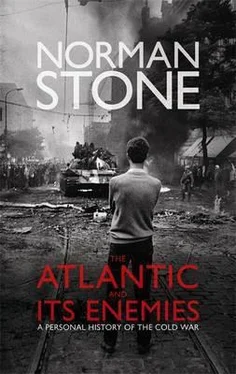16. Atlantic Crisis 1974-1979
Of this period, the fall of Saigon and Phnom Penh in April 1975 was the great symbol — the greatest military and economic power on earth defeated by a small and very determined Communist state. It was a symbol of greater resonance than even earlier such instances, such as the evacuation of Canton in 1949, when Chiang Kai-shek had fled to Taiwan, with his broken army (and the museum treasures of ancient China). In Saigon, there was a general panic, for all the world to see on television, as the helicopters whirred off the roof of the American embassy, crowds of people clutching desperately at the struts. Of course, the supposed peace agreement of 27 January 1973 had been fraudulent, a face-saver for the Americans, and there was a considerable Northern presence in the South. Heavy weaponry was moved along the jungle roads, and 100,000 men came in from the North, with tanks and SAMs. The total force available stood at a million men, regulars and guerrilleros , most of whom did front-line service, whereas Thieu’s American-trained 750,000 men suffered for the enormous ‘tail’ on which the Americans insisted: in effect six men in the rear for every one at the front. Thieu tried to extend his own control in the Mekong Delta, but that only overextended his forces — by now, at least partially, far better than before, and offering one of the might-have-beens of the affair. Then came the oil crisis, depriving the South Vietnamese air force of fuel, which the Americans would only dole out from watering cans; and inflation became much worse. By autumn 1974 the Northern leaders had decided upon a two-year ‘general uprising’ and early in 1975 seized territory adjoining Cambodia, capturing huge amounts of supplies, at that only eighty miles from Saigon. Nixon had promised to ‘respond with decisive military force’, but he was now politically dead, and Thieu was abandoned, to the cheers of Congress.
The Ho Chi Minh Trail, no longer the romantic Guevara pathway, was now double-tracked and paved, with intersections that required traffic managers, and ended close to Saigon. In fact the South could be cut in half, and the North had another advantage, that small attacks in the centre would drive hordes of refugees in panic towards the sea and Saigon, blocking all the roads and preventing the Southern army from moving effectively. That is what happened — a chief city bombarded and isolated, with refugees crowding the roads and even the ports, paralysing the ships. South Vietnamese soldiers themselves panicked, rushing to save their families. A truly ruthless regime would just have machine-gunned the refugees and driven them in a different direction, but Thieu was not made of such stuff, and instead just ordered complete retreat out of the Central Highlands. Masses of troops picked their way through masses of refugees, moving in buses, lorries, private cars, bicycles, all overloaded with people, from babies to aged ancestors, those who fell being crushed by the vehicle behind, while the North Vietnamese threw shells into the crowds. Forty thousand people are said to have died on this exodus, and over $1bn of materiel fell into North Vietnamese hands.
Now came collapse. Thieu hoped to hold on with enclaves that would get American support — Da Nang on the coast, together with Saigon and the Mekong Delta. But, once again, the Northern commanders applied ruthless methods, using refugees to paralyse the defenders’ movements, and attacked towards Hue, a city already vastly demoralized by the Buddhist troubles and swamped in refugees by the North Vietnamese attack of 1972. On 24 March the old fake-imperial city, tinkling bells and all, collapsed, and a million refugees now fled towards Da Nang, where the Americans had had their fortress-port, or tried to get away by sea, clinging to anything that might float. By 29 March Da Nang was falling as well, as official America turned a disdainful back (the ambassador even tried to prevent a decent man, Edward J. Daly, president of World Airways, from sending two Boeing 727s to the city, flying on the first one himself. After landing, his aeroplane was mobbed by thousands of people, some 270 of whom were finally jammed in, under gunfire, and, badly damaged, the aircraft limped heroically back). Then all the other coastal towns fell, Cam Ranh Bay, the great American base, after only thirty minutes of fighting; one airport was captured with more than sixty grounded aircraft. By early April the North Viet namese had cut off Saigon, and were able to shell Bien Hoa airfield. Cambodia was collapsing as well: on 12 April 276 Americans were evacuated from Phnom Penh, which should have been a sign to the still disbelieving Thieu. He hung on to office for another week, desperate to see the B52s return. Instead, he learned on 23 April that President Ford, speaking at a university, had announced that the war in Vietnam ‘is finished as far as America is concerned’. His audience stood up and clapped.
The evacuation of Saigon had itself been held off, to forestall panic, but panic then took hold, as a formation of captured Cessna A-37s bombed the presidential palace. The famous scene came on 29 April, with the helicopter evacuation from the embassy compound itself. Up and down, on film, 6,236 people were taken off through crossfire, the large machines lifting off from the walled-in yard, the smaller ones from the roof; 662 flights were made between Saigon and ships eighty miles away, the crews managing matters with great efficiency and such decency as could be mustered; and the end came at 5 a.m. on 30 April, when the ambassador left. Now, every South Vietnamese who could get away made for the American Seventh Fleet, helicopters landing so fast that they had to be pushed overboard as soon as the occupants had been got out, to make space for the next one: 675,000 refugees were brought to the United States. On 30 April a North Vietnamese tank smashed through the gates of the presidential palace. The stand-in president, the selfsame Duong Van Minh who had once destroyed Ngo Dinh Diem at the Americans’ behest, wanted formally to capitulate. He was told that he no longer had anything to give up, but was allowed, on the radio, to say a few words to the effect that that was that. In Cambodia, at the same moment, there was a similar collapse, as the Khmer Rouge moved in to a silent Phnom Penh, filled with a foreboding that was entirely justified.
To start with, the opponents of the Vietnam War were jubilant: the ‘People’ had triumphed, the Americans and their lackeys were scuttling ignominiously away, as ‘Whites’, in this scenario, were supposed to do. The Communists were even on a best behaviour that comes as a curious shock after the experiences of mismanaged American triumphs, a quarter-century later, in Kosovo or Baghdad, when army engineers were replaced by private contractors. The North Vietnamese worked to get the electricity and water in Saigon going, and for a time there was recovery. But this solicitude for the Saigon population did not last for very long. The usual tyrannical procedures were applied, with attempts at heavy industrialization, and collectivization of agriculture, in a country wrecked by a quarter-century of war. Even the Mekong Delta, from which rice had been exported, saw famine. Anyone connected to the ‘old order’ was ‘re-educated’ in gruesome camps and a secret police had the usual field day. Vietnam was distinguished only by a phenomenon known as the ‘boat people’, as a million people (estimates differ) bribed their way onto open boats to escape, over pirate-ridden seas, to countries such as Malaysia or even Australia, where they were not greatly wanted. About 750,000 of the Chinese minority were floated off from 1978 onwards, taking years to become, eventually very successfully, integrated elsewhere. Meanwhile, Vietnam relapsed into the traditional hostility towards China, and there was even an absurd war. In Cambodia matters were even worse. A provincial peasant and largely teenage Communist Cambodian guerrilla force had started up: the Khmer Rouge. These were led by one Pol Pot, who, though not a great academic success in France, had learned the usual stew of exterminatory Communism that flourished in those parts (Enver Hodža in Albania, and for that matter Andreas Papandreou in Greece, had had the same training). Maoism had glorified the revolutionary peasant, whereas Marx had regarded peasants with contempt — ‘quadrupeds’ (as the French Left saw them). Mao had demonstrated that the peasants were after all revolutionary, that the evil really lay in the towns, where money was made, and foreigners flourished. A sort of mad peasant ideology resulted. On 17 April 1975 the Khmer Rouge invaded the Cambodian capital and declared that townspeople were abolished: 2.5 million people were killed, sometimes horribly, or starved, or worked to death, until the Vietnamese invaded. In later years, ‘boat people’ and the ‘killing fields’ of Cambodia (revealed by an enterprising Hungarian television journalist, Aladár Chrudinak) counted as glaring evidence that the Americans had been right in fighting the Vietnam War, and wrong only in the method with which they had fought it. This is a debate that goes on.
Читать дальше












![Edward Ellis - Adrift on the Pacific - A Boys [sic] Story of the Sea and its Perils](/books/753342/edward-ellis-adrift-on-the-pacific-a-boys-sic-s-thumb.webp)